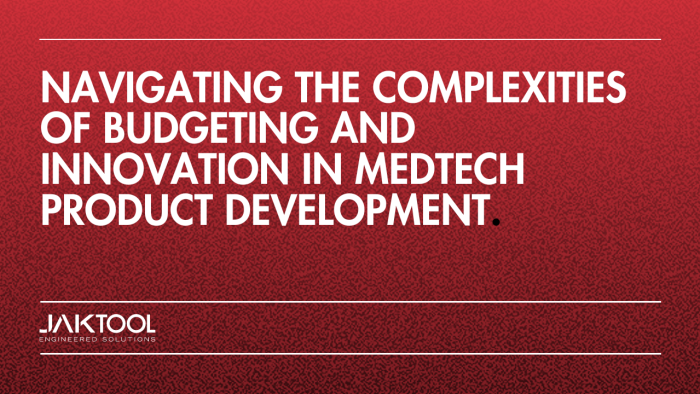Navigating the Complexities of Budgeting and Innovation in MedTech Product Development

The MedTech industry is one of the world’s most dynamic and rapidly evolving sectors. As the demand for innovative medical technologies continues to rise, so does the complexity of bringing these products from concept to market. Central to this process are two critical factors: budgeting and innovation. Balancing these elements is crucial for ensuring the successful development and commercialization of MedTech products.
The Importance of Strategic Budgeting in MedTech
Budgeting in MedTech product development is far from straightforward. It involves more than just allocating funds; it’s about strategically managing resources to foster innovation while meeting financial constraints. Whether you’re a startup or a well-established company, setting a realistic budget that accounts for the entire product lifecycle is essential.
One key challenge in budgeting for MedTech projects is the unpredictability of costs. Unlike other industries, where costs can be more easily forecasted, MedTech projects often involve unique challenges such as regulatory approvals, clinical trials, and specialized manufacturing processes. These factors can lead to significant cost overruns if not carefully managed from the outset.
Balancing Innovation with Cost Constraints
Innovation is at the heart of MedTech. However, the drive to innovate can sometimes conflict with the need to adhere to a strict budget. This is particularly true when new technologies or methods are introduced, which may require substantial investment without a guaranteed return.
To avoid stifling innovation, budgeting must be approached with flexibility. Instead of imposing rigid cost constraints from the beginning, consider adopting a phased approach where costs are closely monitored but not overly restrictive. This allows the development team to explore creative solutions and new technologies without being immediately constrained by cost considerations.
Moreover, clear communication between the development team and stakeholders is vital. Ensuring that all parties understand the potential costs and benefits of pursuing innovative approaches can help in making informed decisions that align with both the project’s financial and innovation goals.
The Role of Stakeholders in MedTech Product Development
Stakeholders play a pivotal role in the budgeting and innovation process. They are often responsible for setting the expectations and priorities for the project. Therefore, managing stakeholder expectations is critical to maintaining a balance between innovation and budget.
Early engagement with stakeholders can help set realistic expectations regarding both the costs and the project timeline. It’s important to communicate that while innovation is necessary for creating competitive and effective medical technologies, it often comes with uncertainties that can impact budgets and timelines.
Navigating Project Transitions
MedTech projects often span several years, during which time there may be project leadership changes or shifts in market conditions. These transitions can complicate the budgeting and innovation balance. To mitigate these risks, it’s essential to maintain continuity in project management and ensure that a clear roadmap is in place.
A comprehensive funding roadmap that anticipates potential cost increases and includes contingencies for unexpected challenges can be invaluable. This roadmap should be revisited regularly, especially when significant changes in the project’s direction or new stakeholders come on board.
Knowing When to Pivot or Preserve
One of the most challenging decisions in MedTech product development is knowing when to pivot or preserve the current course. This decision often hinges on the results of ongoing testing and market feedback. If a project encounters repeated failures or the market conditions change dramatically, it may be wise to reconsider the current approach.
However, it’s equally important to recognize when perseverance is needed. Not all innovations succeed on the first try, and some of the most successful MedTech products have come from projects that initially faced significant challenges. The key is to base decisions on data-driven insights and to remain flexible in your approach.
Strategic Planning for MedTech Success
Balancing budgeting and innovation in MedTech product development is a complex but essential task. By adopting a strategic approach to budgeting, fostering open communication with stakeholders, and remaining flexible in the face of challenges, MedTech companies can navigate the complexities of product development and bring innovative technologies to market successfully. As the industry continues to evolve, these strategies will remain crucial for maintaining a competitive edge and delivering valuable medical technologies to those who need them most.
WHAT IS THE VISION VAULT?
The JAKTOOL Vision Vault is a space for us to expand on the passions that drive innovation and growth at our company. On this blog, we’ll take deeper dives into industry news and our expertise and highlight the leaders we have under our own roof through featured blogs. Follow along for updates throughout the month and recaps on new episodes of JAKTALK, our biweekly podcast hosted by our founder, COO, chairman, and visionary, Jeff Kinsberg.
This article is a recap of JAKTALK episode #13. You can watch the full episode on YouTube below:
This episode features JAKTOOL COO & Founder Jeff Kinsberg, along with MedTech Program Manager Paola Torres.
